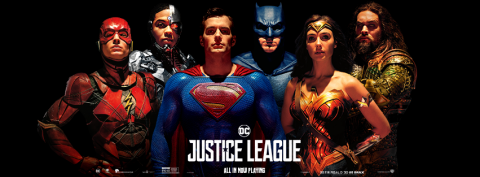Fans of DC comics as well as some critics have likened “Justice League” to an episode of the popular TV show from 2001 that went by the same name. As a fan of the show, this comparison was exciting to me, giving me a nostalgic incentive to view it. Unfortunately, if this movie were an episode of the television show, I would probably label it low tier relative to the others. The animated television series’ take on the Justice League was distinguishably smarter, deeper, and a lot less expensive.
“Justice League” picks up not too long after the events of “Batman v Superman: Dawn of Justice.” As indicated by generic criminals yelling at shop owners and knocking over fruit stands in slow motion, the death of Superman has plunged the world into a state of chaos. It is under these circumstances that a new threat presents itself. Noticing evidence of trouble to come, Batman (Ben Affleck) begins reaching out to super-powered people that have been caught on tape using their abilities.
The villain of this film calls himself Steppenwolf (Ciarán Hinds), and if you ask someone who has seen this movie about his evil plan, they will likely recall his efforts to collect three boxes from across the world. They may even remember that centuries ago, a conflict with Steppenwolf ended with the boxes being allocated to three peoples: the Amazons who share a home with Wonder Woman (Gal Gadot); the Atlanteans of whom Aquaman (Jason Momoa) is king; and mankind. However, it would be more of an anomaly to find someone that can explain what he really wants to do with these boxes. Part of this problem may come from Steppenwolf having no one to talk to on screen other than his opponents.
A new character, Cyborg (Ray Fisher), has a special connection with mankind’s box that makes him worthy of some attention. The other heroes tend to be behind the audience in what they know, but Cyborg at least keeps up. Also, his existential challenges as half-man, half-circuitry set up a pathway for growth that is tolerably fulfilled. Fisher delivers a more than acceptable performance despite the script’s blundering attempt to give the characters many interesting things to do.
The acting in this movie is mostly competent. Gal Gadot secures Wonder Woman as a confident heroine and an audience favorite, and Jason Momoa brings a spirited toughness to Aquaman that generates some appeal. Ezra Miller’s Flash worked for me about 50 percent of the time. His comic relief would have had me laughing hysterically as a 10-year-old, but at this point in my film-watching career, Miller’s comedic content and delivery felt stale.
Finally, Ben Affleck has failed in two movies to convince me that he’s actually Batman. I notice him wearing the costume, but all I really see is an actor looking pretty tired of his role already.
There are some great action sequences in “Justice League,” especially when we get to see our heroes square off against one another or when they are given opportunities to use their own unique powers in a way that makes each of them indispensable to the team. These moments work, and if built logically into the plot and progression of the movie, should be used again in future franchise entries.
The CGI was a tool used more to dazzle than to convince. I realize we’re probably stuck with the electricity effect that accompanies the Flash, but I found it distracting. Batman had very few noteworthy action moments, but I do love the way this version of Batman is designed to move on screen. Whether he is being stealthy or aggressive, his movement maintains a certain intensity.
With a few exceptions, a major problem with “Justice League” is that it fails to follow the rule “show, don’t tell.” The dynamics of the plot are revealed almost exclusively through expository dialogue and images on computer screens. The team is essentially built when it would have been far more interesting to watch our heroes come together by nature.
Still, “Justice League” is undoubtedly a better movie than “BvS” and “Suicide Squad.” There is a plot at work, despite its dullness, and humanity makes an appearance within all of the characters. While these films (other than maybe “Wonder Woman”) have repeatedly failed to tell good stories, “Justice League” leaves a viable framework intact.
I will continue to criticize DC movies for their failures when necessary. But if Warner Brothers can get their act together, hire writers with an effective love and understanding of these characters, and tell just one good story, then I will allow this franchise some vindication, even at the cost of over a billion dollars invested in disappointment.
This movie is not quite up to par with its animated predecessor, but the analogy is useful. Many of the DC heroes are gods in some sense with cosmic responsibilities, and the television show always presented an interesting take on how the characters manage these circumstances. Pulling greater inspiration from the approach used by the show could bode well for the future of the Justice League.
Dillon MacInnis can be reached at [email protected].



















